Software Monetization (SM) emerged as a strategy around 2010, combining licensing entitlement management and software code protection through techniques like obfuscation and encryption. It has since evolved to include automation and user usage behavior analysis. SM is now integral to various industries, with even companies like General Electric transitioning into software-centric businesses. Sales of Software Licensing and Monetization (SLM) tools are rapidly increasing globally, with double-digit growth expected until 2025. The market size for hardware, software, and services related to software monetization was USD 364.6 million in 2018 and is projected to reach USD 718.5 million in 2025 due to technological advancements.

Abstract
Purpose: The surge in leveraging software for profit has propelled the adoption of “Software Monetization” (SM) as a strategic business approach. The Software Licensing and Monetization (SLM) tool is essential for vendors to achieve their strategic objectives. However, challenges persist in the rapid adoption of this tool within their organizations. As a result, vendors find themselves at a competitive disadvantage, limiting their ability to maximize profits and increasing production costs for their final products. This paper introduces a conceptual framework to address the vital need for a comprehensive industrial model in the SM sector.
Design/Methodology: Using a qualitative approach, this study uses a meta- analytical method to inductively examine the literature on Software Monetization (SM), Software Licensing and Monetization (SLM) tools, and technology monetization and adoption. Expert interviews were employed to triangulate the literature review, informing the development of a conceptual framework.
Findings: The research unveils a notable absence of Software License Management (SLM) solutions among many market vendors, possibly due to a limited understanding of software monetization and available tools. Despite the growing significance of Software Monetization, vendors lack a cohesive process in their organizations. Various factors, including cultural, economic, and pricing influences, impact adoption. Remarkably, there’s a dearth of studies employing a technology adoption model as industry guidance.
Limitations: Filling a void, this paper utilized the Technology Acceptance Model (TAM) as the foundational theory, expanding insights with novel constructs — market forces, processes, and internal variables — pertinent to Software Monetization (SM) adoption behavior. Emphasizing global relevance, the paper introduces cultural factors to comprehend their impact on Software Licensing and Monetization (SLM) adoption behavior.
Practical Implications: The proposed conceptual framework promises substantial managerial advantages for stakeholders in software monetization. It aids software vendors in the streamlined adoption of Software Licensing and Monetization (SLM) tools, offering insights into barriers and cost/resource comparisons. End users gain clarity on SLM-protected system processes and automation possibilities. Primary SLM tool providers can optimize market strategies, overcome obstacles in marketing plan development and tailor region-specific approaches for successful market entry.
Value: The focus centered on “Software Monetization” and related tools, specifically “Software Licensing and Monetization.” This paper marks the inaugural investigation into organizational adoption patterns of this technology. The uncovered insights and outlined conceptual framework stand as a valuable reference for suggesting future studies in this domain.
Link to full article: Exploring the commercial adoption behavior of software licensing & monetization (SLM) tool



